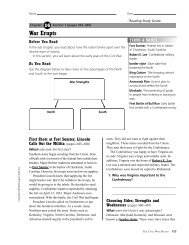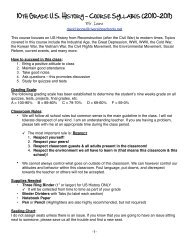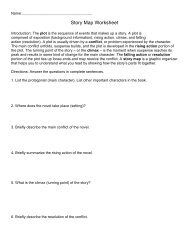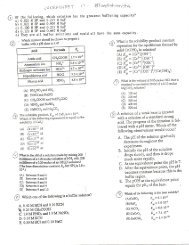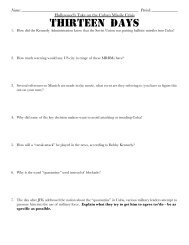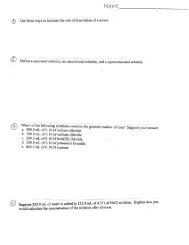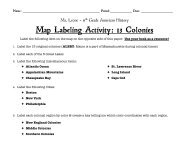Chapter 16 Text
Chapter 16 Text
Chapter 16 Text
You also want an ePaper? Increase the reach of your titles
YUMPU automatically turns print PDFs into web optimized ePapers that Google loves.
<strong>16</strong>.6 Weak Acids 631<br />
This expression leads to a quadratic equation in x, which we can solve by using<br />
an equation-solving calculator or by using the quadratic formula; We can also<br />
simplify the problem, however, by noting that the value of Ka is quite small. As<br />
a result, we anticipate that the equilibrium will lie far to the left and that x will be<br />
very small compared to the initial concentration of acetic acid. Thus, we will<br />
assume that x is negligible compared to 0.30, so that 0.30 - x is essentially equal<br />
to 0.30.<br />
0.30 -x** 0.30<br />
As we will see, we can (and should!) check the validity of this assumption<br />
when we finish the problem. By using this assumption, Equation <strong>16</strong>.30 now<br />
becomes<br />
Solving for x, we have<br />
0.30<br />
= 1.8 X 10~5<br />
.2 _ = (0.30)(1.8 x = 5.4 X 10"6<br />
x = V5.4 X 10~6 = 2.3 X 10~3<br />
[H+] = x = 2.3 X 10~3 M<br />
PH = -log(Z3 X 10~3) = 2.64<br />
We should now go back and check the validity of our simplifying assumption<br />
that 0.30 - x — 0.30. The value of x we determined is so small that, for this<br />
number of significant figures, the assumption is entirely valid. We are thus satisfied<br />
that the assumption was a reasonable one to make. Because x represents<br />
the moles per liter of acetic acid that ionize, we see that, in this particular case,<br />
less than 1% of the acetic acid molecules ionize:<br />
Percent ionization of HC2H3O2 = n x 100% = 0.77%<br />
As a general rule, if the quantity x is more than about 5% of the initial value, it<br />
is better to use the quadratic formula. You should always check the validity of<br />
any simplifying assumptions after you have finished solving a [problem.<br />
Finally, we can compare the pH value of this weak acid tp a solution of a<br />
strong acid of the same concentration. The pH of the 0.30 M solution of acetic acid<br />
is 2.64. By comparison, the pH of a 0.30 M solution of a strong acid such as HC1<br />
is -log(O.SO) — 0.52. As expected, the pH of a solution of a weak acid is higher<br />
than that of a solution of a strong acid of the same molarity.<br />
When in doubt, work the problem<br />
assuming ([HA]0 - x) ~ [HA]0. After<br />
solving for x, compare x to [HA]0. If<br />
x > 5% of [HA]0, rework the<br />
problem using the quadratic<br />
formula.<br />
SAMPLEEXEROSE<strong>16</strong>.il<br />
Calculate the pH of a 0.20 M solution of HCN. (Refer to Table <strong>16</strong>.2 or Appendix D for<br />
the value of Ka.)<br />
Solution<br />
Analyze and Plan: We are given the molarity of a weak acid and are asked for the pH.<br />
From Table <strong>16</strong>.2, Ka for HCN is 4.9 x 10~10. We proceed as in the example just worked<br />
in the text, writing the chemical equation and constructing a table of initial and equilibrium<br />
concentrations in which the equilibrium concentration of H+ is our unknown.<br />
Solve: Writing both the chemical equation for the ionization reaction that forms H" (ay)<br />
and the equilibrium-constant (Ka) expression for the reaction:<br />
[H+1[CN~<br />
[HCN]<br />
- 4.9 X 10~10



